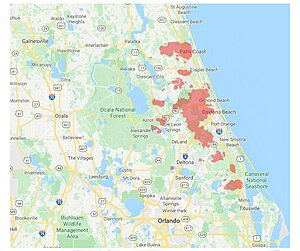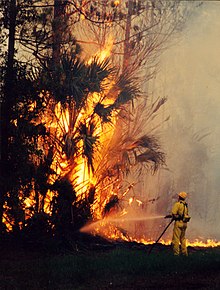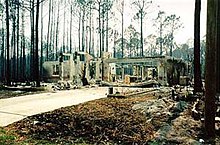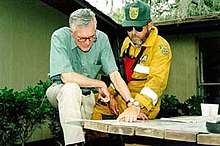
A firefighter is a first responder trained in firefighting, primarily to control and extinguish fires that threaten life and property, as well as to rescue persons from confinement or dangerous situations. Male firefighters are sometimes referred to as firemen.

A fire engine is a road vehicle that functions as a firefighting apparatus. The primary purposes of a fire engine include transporting firefighters and water to an incident as well as carrying equipment for firefighting operations in a fire drill. Some fire engines have specialized functions, such as wildfire suppression and aircraft rescue and firefighting, and may also carry equipment for technical rescue.

A person who engages in firefighting is known as a firefighter or fireman. Firefighters typically undergo a high degree of technical training. This involves structural firefighting and wildland firefighting. Specialized training includes aircraft firefighting, shipboard firefighting, aerial firefighting, maritime firefighting, and proximity firefighting.

A firebreak or double track is a gap in vegetation or other combustible material that acts as a barrier to slow or stop the progress of a bushfire or wildfire. A firebreak may occur naturally where there is a lack of vegetation or "fuel", such as a river, lake or canyon. Firebreaks may also be man-made, and many of these also serve as roads, such as a logging road, four-wheel drive trail, secondary road, or a highway.

Aerial firefighting, also known as waterbombing, is the use of aircraft and other aerial resources to combat wildfires. The types of aircraft used include fixed-wing aircraft and helicopters. Smokejumpers and rappellers are also classified as aerial firefighters, delivered to the fire by parachute from a variety of fixed-wing aircraft, or rappelling from helicopters. Chemicals used to fight fires may include water, water enhancers such as foams and gels, and specially formulated fire retardants such as Phos-Chek.
Firefighting jargon includes a diverse lexicon of both common and idiosyncratic terms. One problem that exists in trying to create a list such as this is that much of the terminology used by a particular department is specifically defined in their particular standing operating procedures, such that two departments may have completely different terms for the same thing. For example, depending on whom one asks, a safety team may be referred to as a standby, a RIT or RIG or RIC, or a FAST. Furthermore, a department may change a definition within its SOP, such that one year it may be RIT, and the next RIG or RIC.
This glossary of wildfire terms is a list of definitions of terms and concepts relevant to wildfires and wildland firefighting. Except where noted, terms have largely been sourced from a 1998 Fireline Handbook transcribed for a Conflict 21 counter-terrorism studies website by the Air National Guard.

The Sikorsky S-64 Skycrane is an American twin-engine heavy-lift helicopter. It is the civil version of the United States Army's CH-54 Tarhe. It is currently produced as the S-64 Aircrane by Erickson Inc.
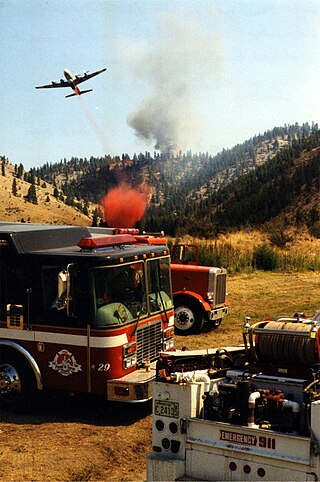
Wildfire suppression is a range of firefighting tactics used to suppress wildfires. Firefighting efforts in wild land areas require different techniques, equipment, and training from the more familiar structure fire fighting found in populated areas. Working in conjunction with specially designed aerial firefighting aircraft, these wildfire-trained crews suppress flames, construct fire lines, and extinguish flames and areas of heat to protect resources and natural wilderness. Wildfire suppression also addresses the issues of the wildland–urban interface, where populated areas border with wild land areas.
The following outline is provided as an overview of and topical guide to firefighting:

Helitack crews are teams of wildland firefighters who are transported by helicopter to wildfires. Helicopters provide rapid transport, enabling helitack crews to quickly respond and assess a wildfire situation. Helitack crews may land near a wildfire or, if equipped and trained, rappel from a hovering helicopter. Once on the ground, crews build firelines using hand tools, chainsaws, and other firefighting tools. They often remain overnight in remote locations. After they have completed their assignment, crew members may pack up to 120 pounds of equipment over difficult terrain to reach a pick-up point. Rappellers often prepare helispots that provide better access to a fire. Helicopter crew members may also perform other duties such as tree falling, firing operations, and managing helibases.
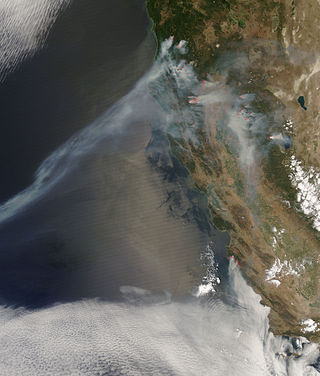
The 2008 California wildfire season was one of the most devastating in the state of the 21st century. While 6,255 fires occurred, about two-thirds as many as in 2007, the total area burned— 1,593,690 acres —far exceeded that of previous years.

The Long Draw Fire was a wildfire started by a lightning strike on July 8, 2012 that burned 557,648 acres (2,257 km2) acres in southeastern Oregon, in the Western United States. It was Oregon's largest wildfire since the 1865 Silverton Fire which burned over 1 million acres.

The 2018 Washington wildfire season officially began June 1, 2018. A statewide state of emergency was declared by Governor Jay Inslee on July 31.

The 2020 Washington wildfire season officially began in March 2020. The season was a part of the 2020 Western United States wildfires. By September, wildfires had burned over 713,000 acres, 181 homes had been lost, and one death occurred as a result. The 2020 fire season saw more individual fires than in any other recorded year.

The Glass Fire was a wildfire in Northern California, that started on September 27, 2020, at 3:48 AM (PDT) from an undetermined cause and was active for 23 days. It was part of the 2020 California Wildfires and the 2020 Western United States wildfire season. The fire was named due to its origin nearby Glass Mountain Road in Deer Park, Napa County, and it extended also into Sonoma County. Initially a single 20-acre brush fire, it rapidly grew and merged with two smaller fires that expanded to 11,000 acres during the night of September 27 into September 28.

The Goodwin Fire was a wildfire that burned 28,516 acres (11,540 ha) in the U.S. state of Arizona over 16 days, from June 24 to July 10, 2017. The fire destroyed 17 homes and damaged another 19 structures, but no firefighters or civilians were injured or died in the fire. Investigators did not determine any particular cause for the fire.

The 2020 Dome Fire was a large and ecologically destructive wildfire in the Mojave National Preserve in California's San Bernardino County. Caused by a lightning strike on August 15, the fire began near Cima Dome and exhibited rapid growth over the following 36 hours, aided by weather conditions and a lack of available firefighting resources. During this period the Dome Fire destroyed only 6 structures, but burned more than a quarter of the Cima Dome Joshua tree forest, one of the largest and densest populations of Joshua trees known in the world. The fire killed as many as 1.3 million Joshua trees. No injuries or fatalities were reported among firefighters or civilians. The fire cost US$2.2 million to suppress, and burned 43,273 acres (17,512 ha) before being fully contained on August 24.

The Silver Fire was a 1987 wildfire in the Siskiyou National Forest in Oregon. It burned 96,240 acres (389 km2), of which 42,350 acres (171 km2) was located in the Kalmiopsis Wilderness. Parts of its burned area were re-burned in the Biscuit Fire and the Chetco Bar Fire. It was started by a lightning strike near Silver Creek on August 30, and was contained on November 2 after a dry summer in the area, with relative humidity as low as 4% at times in certain places, was ended by heavy rain. Firefighters from across the country, as far away as Virginia, went to Oregon to fight the fire. Nearly 4,000 people were involved in the effort.
